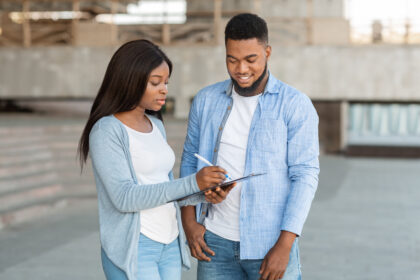So often, I’ve talked about the importance of communication in a relationship. It’s one of the most important things you can cultivate in your relationship, alongside trust and friendship. They all play off each other to develop love, intimacy, and a healthy relationship, but I haven’t talked about nonverbal communication and its role in your relationship yet. Nonverbal communication might not seem as necessary, but so much can be said without exchanging words between you and your partner. It’s sort of like when you’re out with friends and have a whole conversation with your partner just by making eye contact. (IYKYK, and if you don’t, then I’m sorry. You’re missing out.)
Nonverbal Communication
Resting B Face
I don’t know about you, but I’ve been blessed with resting b**** face. I look intimidating at times. I can’t help it, but it’s something I live with daily. And no, this isn’t me saying you should smile more. But if you are mindful of your facial expressions might make verbal communication easier. With my resting B face, sometimes what I say doesn’t match my face, leading to miscommunications and misunderstandings. Nine times out of ten, I am not annoyed at you. My face looks like it, and wearing a mask over the last few years has only worsened it. I’m saying to be mindful of what your face looks like when you say something.
Where Are Your Eyes Looking?
When you look at something or someone you like, your eyes dilate and you blink more than usual. It’s our version of wagging our tails. Sometimes I am through with a conversation, and my eyes start to wonder. The first part of active listening is looking at the person talking. Otherwise, I will get distracted by the lights or dust floating in the air, and now the words spoken to me go in one ear and out the other. (I’m severely ADHD, if you can’t tell. I’m like the dog from UP. SQUIRREL!) Be mindful of where you are looking, and pay attention to someone when they are speaking to you. Eye contact makes a huge difference during an argument. You will look like you are listening instead of waiting for your turn to talk.
Applied Knowledge
I could sit here and write out all the different kinds of nonverbal communication in the world, but knowledge without application is useless. So instead of listing them all, I’ll take this chance to give a few examples you might want to implement in your relationship.
- Lean in towards your partner when they are talking. It will show you are interested in what they are saying and that you are actively listening.
- Appearing swiftly when summoned. This might sound weird to some, but you know when your mom used to yell at you across the house to “come here.” I don’t know about you, but I would take my time moseying across the house. (ADHD at its finest.) Appearing swiftly or even just answering quickly when your partner calls you is a simple but effective way to apply positive nonverbal communication into your life.
- Be aware of your partner’s body language. Body language is one of the biggest indicators of nonverbal communication. There is a reason you know your partner is mad at you before you talk to them. Arms crossed, eyebrows furrowed, maybe they have that scary look in their eyes that lets you know you’re in trouble. Or perhaps you can tell they are sad or something is bothering them without them having to say anything. Paying attention and being acutely aware of your significant other’s body language can help open verbal communication and allow you to talk to them about whatever is bothering them.
Practice Makes Perfect
Healthy and patient communication take time and practice. You don’t go to the gym and deadlift 300 pounds on the first day. You can’t throw a 100-mile fastball the first time you throw a pitch, so levy your expectations over communication. You have your bad habits, and so does your significant other. Learn to grow past those bad habits together and form newer and healthier ones in your relationship. Awareness of nonverbal communication and implementing some of the tips can help jumpstart your growth together, and help you navigate your relationship and what communication will look like between you and your partner.




